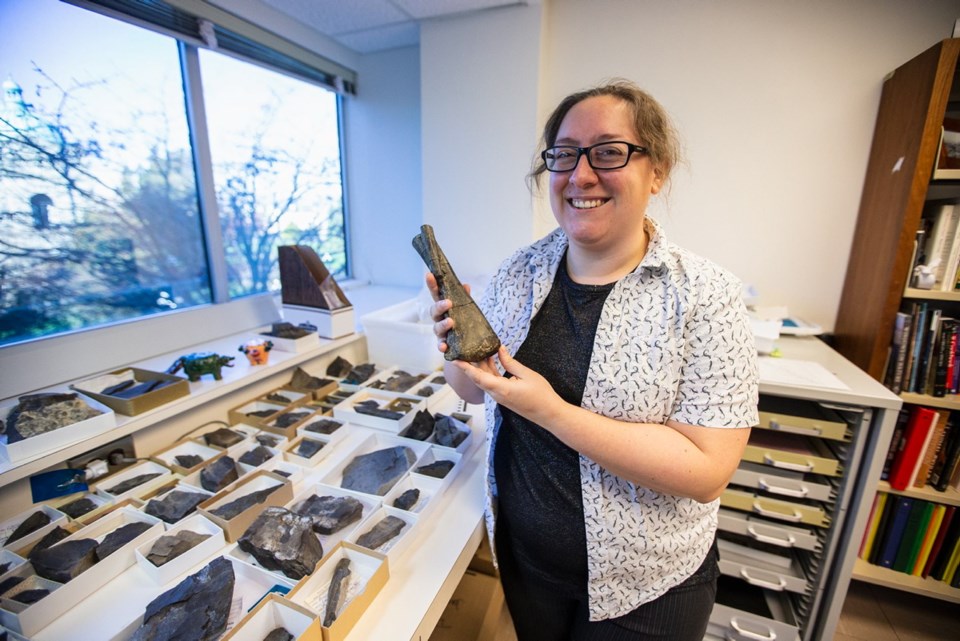The new curator of paleontology at the Royal B.C. Museum is thrilled with the fossils at her new place of work. They’re lacking just one element, however: dinosaurs.
“We don’t have many vertebrate animals, which are the things I like to study,” said Victoria Arbour.
“But that’s great for me, because it means I can contribute to the museum’s collection and to the knowledge of British Columbia’s fossil record.”
The museum has collections of marine animals, along with plants and trees. But fossils of dinosaurs are few, at least for now.
Arbour arrived in Victoria in August to take up her new position, a first for the museum. While the RBCM has had notable paleo-experts on staff in the past, Arbour is the first whose position is devoted entirely to paleontology.
Already, her arrival has earned praise from scientists, fossil hunters and dinosaur enthusiasts. “This is really an excellent move by the museum, to create a curator of paleontology,” said Chris Barnes, professor emeritus in the School of Earth and Ocean Sciences at the University of Victoria and a paleontologist whose principal study involved conodonts, extinct eel-like fish.
“It’s very good for the museum to bring in someone of [Arbour’s] standing and energy and someone with an enthusiasm for increasing the public awareness of paleontology.”
Arbour, originally from Nova Scotia, studied at Dalhousie University before completing a master’s and PhD at the University of Alberta. She has also worked at the Museum of North Carolina and the Royal Ontario Museum.
Her biggest love has always been dinosaurs, the subject of most of her scientific study.
“I was just one of those kids who really liked dinosaurs and never grew out of that place,” said Arbour. “When you are little, they are big and fascinating and they are in front of you all the time in toys and books.
“As an adult, what I find really interesting is what we can learn about deep-time history of life on Earth.”
Arbour’s own expertise centres around ankylosaurs — squat, four-legged, plant-eating dinosaurs whose outer skin was protected by armour made of bony plates. Some ankylosaurs were also armed with a bony club on the end of the tail, whose function, said Arbour, has not been entirely settled.
Did natural selection create it as a weapon to be used as protection against predators? Perhaps the tail club was used against other ankylosaurs during combat over mating rights. Evolutionarily designed weapons, noted Arbour, are often about mating rights.
Another detail about ankylosaurs that intrigues Arbour is that they turns up along an evolutionary cul de sac. No close evolutionary relatives remain.
So unlike many more familiar dinosaurs, the evolutionary path of the ankylosaurs does not carry on into modern birds.
“Birds are living dinosaurs,” she said. “But the dinosaurs that I particularly like, the ankylosaurs, are on their own evolutionary branch and don’t have any close living relatives.
“The ankylosaurs are about as far away from a bird as you can get and still be a dinosaur.”
Now that she is in Victoria, Arbour has looked over the museum’s fossil collections and scouted out fossil sites on Vancouver Island, including a spot near Courtenay that appears to contain the buried skeleton of an elasmosaur, a long-necked marine dinosaur.
While she said it’s too early to make any commitments, given budget considerations and other issues, Arbour is enthusiastic about the idea of the Royal B.C. Museum being actively engaged in a dig offsite to unearth a dinosaur’s skeleton.
She’s enthusiastic about the museum’s collection, in particular its McAbee fossils, found near Cache Creek, now a B.C. heritage site. The McAbee fossil beds contain the remains of a 50-million-year-old lake bed, rich with the prehistoric remains of plants and insects.
Most of the McAbee collection, acquired only last summer, has yet to be catalogued, and Arbour is delighted at the idea of undertaking such a task.
She is also thrilled to be working in a province that contains the World-Heritage listed Burgess Shale fossil beds.
The Burgess fossils, found near Field in the Rocky Mountains in Yoho National Park, are the remains of soft-bodied creatures that lived 508 million years ago, some of the oldest-known prehistoric animal remains in the world.
“We [in B.C.] have this absolutely amazing fossil record that spans this huge chunk of time,” said Arbour. “We go all the way back to the Burgess Shale, 500 million years ago, right up to the ice age, just a few thousands of years ago and everything in between.”
The one thing that has yet to be found in large quantities in B.C. is dinosaurs. And while none of Arbour’s beloved ankylosaurs have been unearthed, some encouraging signs have been found.
“We have found fossil footprints … up near Tumbler Ridge,” said Arbour. “But we haven’t got a lot of bones yet.
“But we’ll find some of those guys, eventually.”



